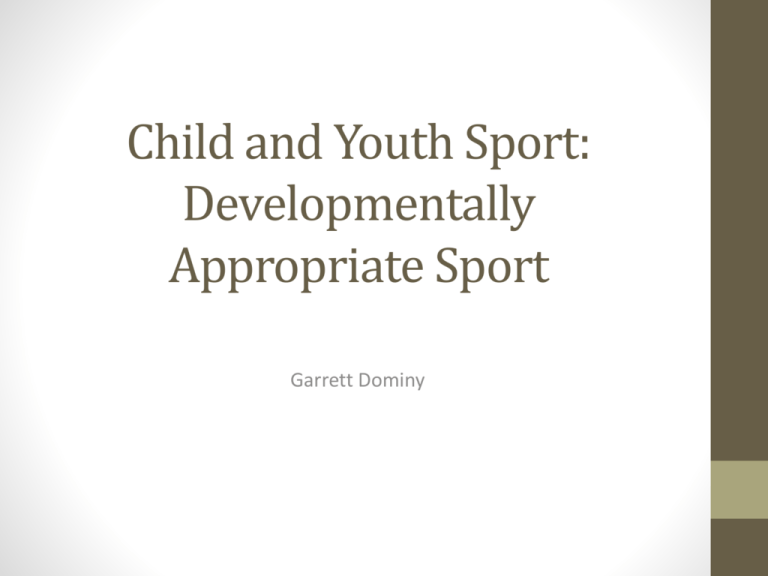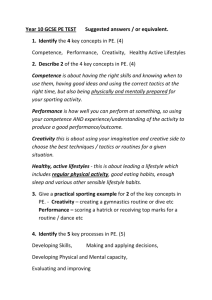Child and Youth Sport: Developmentally Appropriate Sport
advertisement

Child and Youth Sport: Developmentally Appropriate Sport Garrett Dominy Major Questions: • What is developmentally appropriate sport? • What factors should be considered when planning developmentally appropriate sports and practices? Developmentally Appropriate Sport: • Developmentally appropriate sport includes tasks and activities that accommodate both the ability and confidence level of the individual. • Dependent on the developmental stage of a child Children are not mini-adults: • Children’s minds and bodies function differently from adults. • Children do not yet have specific skills to specialize in a certain sport. • While adults play sports for a vast majority of reasons, children play them for fun. • Try to: • Eliminate the negative • Play cooperative games Developmental stages of children: • Early childhood • Middle childhood • Late childhood • Early adolescence • Late adolescence Early Childhood: • Age: 3-5 years old • Motor skills: • Limited fundamental sport skills (running, throwing, kicking) • Vision: • Not mature until 6 to 7 years of age • Difficulty tracking and judging the speed of moving objects • Learning: • Very short attention span • Skill emphasis: • Emphasize fundamental skills • Play rather than competition • Suggested activities: • Running, tumbling, throwing, catching, riding a tricycle or bicycle with training wheels Middle Childhood: • Age: 6-9 years old • Motor skills: • Mature fundamental sport skills • Better posture and balance. Beginning transitional skills (throwing for distance) • Vision: • Improved tracking but limited directionality • Learning: • Short attention span • Limited memory and rapid decision-making skills • Skill emphasis: • Emphasize fundamental skills and beginning transitional skills • Suggested activities: • Entry-level sports • Soccer, dancing, swimming, tee-ball, etc. Late Childhood: • Age: 10-12 years old • Motor skills: • Improving transitional skills • Mastering complex motor skills • Vision: • Mature adult patters • Learning: • Selective attention • Memory skills improving • Skill emphasis: • Emphasize skill with increase on tactics and strategy • Suggested activities: • Entry-level football, slightly more advanced team sports Early Adolescence: • Age: 13-15 years old • Motor skills: • Tremendous growth but loss of flexibility • Vision: • Adult patters • Learning: • Improved attention span • Good memory skills; able to recognize plays and strategize • Skill emphasis: • Individual strengths • Suggested activities: • Majority of sports if mature enough Late Adolescence: • Age: 16-18 years old • Motor skills: • Continued growth into adulthood • Vision: • Adult patters • Learning: • Good attention span and memory skills • Skill emphasis • Continued emphasis on individual strengths • Suggested activities • All sports depending on interest Factors: • Different factors to think about when planning developmentally appropriate sport and practices • Curriculum • Adapted for those who are ahead as well as those who are behind • Process • Activities used so that learning takes place • Context • Why are these sports/activities chosen and why are they learning these skills? Teachers and Coaches: • Appropriate curriculum • Outdoor/indoor play • Time/duration • Focus more on teaching rather than winning or losing • Age specific • Observe and evaluate children’s developmental levels • Ability and confidence • Health of the child Pros: • Advantages of developmentally appropriate sports: • • • • Children are allowed to learn under their own control Fewer injuries Children are able to experience all types of sports Healthier Cons/Debated Topics: • Weightlifting • Necessary for athletics/sports but potentially harmful to young children • Gymnastics • Could potentially stunt growth for young children when started at an early age • Professional athlete? Injuries: • Physical and mental: • • • • • Stunting growth Broken bones Concussions Learning disabilities Loss of interest in physical activity and sports • Obesity • Health later in life Extraordinary cases: • In some cases there are children that are more highly developed than the majority of other kids their age • Capable of extreme feats of muscular strength, endurance, and skill well past the expectations for their age • https://www.youtube.com/watch?v=nkrrKvgDWC8 • https://www.youtube.com/watch?v=BIqVvRh_cEY References: • Paediatr Child Health. 2005 Jul-Aug; 10(6): 343–344. • http://www.ncbi.nlm.nih.gov/pmc/articles/PMC2722975/ • Siedentop, Daryl; van der Mars, Hans. Introduction to Physical Education, Fitness, and Sport, 8th Edition







